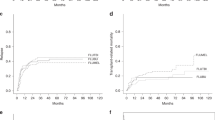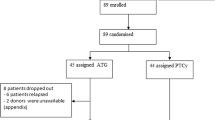Summary:
A total of 40 patients with relapsed/refractory Hodgkin's disease (HD) underwent reduced-intensity conditioning (RIC) allogeneic stem cell transplantation (allo-SCT) from an HLA-identical sibling (n=20) or a matched unrelated donor (n=20). The median age was 31 years (range 18–58). Disease status at allo-SCT was refractory relapse (n=14) or sensitive relapse (n=26). The conditioning regimens were fludarabine-cyclophosphamide±antithymocyte globulin (n=14), a less intensive regimen, and fludarabine-melphalan (FM) (n=26), a more intensive one. The two groups had similar prognostic factors. The median time to neutrophil recovery (ie absolute neutrophil count ⩾500/μl) was 12 days (range 10–24). The median time to platelet recovery (ie platelet count ⩾20 000/μl) was 17 days (range 7–132). Day 100 and cumulative (18-month) transplant-related mortalities (TRMs) were 5 and 22%. Twenty-four patients (60%) are alive (14 in complete remission or complete remission, unconfirmed/uncertain) with a median follow-up of 13 months (4–78). In all, 16 patients expired (TRM n=8, disease progression n=8). FM patients had better overall survival (73 vs 39% at 18 months; P=0.03), and a trend towards better progression-free survival (37 vs 21% at 18 months; P=0.2). RIC allo-SCT is feasible in relapsed/refractory HD patients with a low TRM. The intensity of the preparative regimen affects survival.
This is a preview of subscription content, access via your institution
Access options
Subscribe to this journal
Receive 12 print issues and online access
$259.00 per year
only $21.58 per issue
Buy this article
- Purchase on Springer Link
- Instant access to full article PDF
Prices may be subject to local taxes which are calculated during checkout






Similar content being viewed by others
References
Urba WJ, Longo DL . Hodgkin's disease. N Engl J Med 1992; 326: 678–687.
Aisenberg AC . Problems in Hodgkin's disease management. Blood 1999; 93: 761–779.
Linch DC, Goldstone AH . High-dose therapy for Hodgkin's disease. Br J Haematol 1999; 107: 685–690.
Forman SJ . Role of High-Dose Therapy and Stem Cell Transplantation in the Management of Hodgkin's Disease. American Society of Clinical Oncology (ASCO) Educational Book: Alexandria, VA, 1997, pp 244–247.
Johnston LJ, Horning SJ . Autologous hematopoietic cell transplantation in Hodgkin's disease. Biol Blood Marrow Transplant 2000; 6: 289–300.
Gajewski JL, Phillips GL, Sobocinski KA et al. Bone marrow transplants from HLA-identical siblings in advanced Hodgkin's disease. J Clin Oncol 1996; 14: 572–578.
Milpied N, Fielding AK, Pearce R, et al, for the European Group for Blood and Marrow Transplantation. Allogeneic bone marrow transplant is not better than autologous transplant for patients with relapsed Hodgkin's disease. J Clin Oncol 1996; 14: 1291–1296.
Anderson JE, Litzow MR, Appelbaum FR et al. Allogeneic, syngeneic and autologous marrow transplantation for Hodgkin's disease: the 21-year Seattle experience. J Clin Oncol 1993; 11: 2342–2350.
Akpek G, Ambinder RF, Piantadosi S et al. Long-term results of blood and marrow transplantation for Hodgkin's lymphoma. J Clin Oncol 2001; 19: 4314–4321.
Martino R, Sierra J . Allogeneic hematopoietic stem cell transplantation after immunosuppressive but non-myeloablative conditioning: ‘miniallografts’ are no small matter. Haematologica 1998; 83: 865–867.
Champlin R, Khouri I, Kornblau S et al. Allogeneic hematopoietic transplantation as adoptive immunotherapy: induction of graft-vs-malignancy as primary therapy. Hematol Oncol Clin North Am 1999; 13: 1041–1057.
Peggs KP, Thomson K, Chopra R et al. Long term results of reduced intensity transplantation in multiply relapsed and refractory Hodgkin's lymphoma: evidence of a therapeutically relevant graft-versus-lymphoma effect (abstract). Blood 2003; 102: 198a.
Robinson SP, Sureda A, Mackinnon S et al. Reduced intensity allogeneic stem cell transplantation for Hodgkin's disease: an analysis from the European Group for Blood and Marrow Transplantation (abstract). Blood 2002; 100: 144a.
Anderlini P, Giralt S, Andersson B et al. Allogeneic stem cell transplantation with fludarabine-based, less intensive conditioning regimens as adoptive immunotherapy in advanced Hodgkin's disease. Bone Marrow Transplant 2000; 26: 615–620.
Yam P, Petz L, Knowlton R et al. Use of DNA restriction fragment length polymorphism to document marrow engraftment and mixed hematopoietic chimerism following bone marrow transplantation. Transplantation 1987; 43: 399–405.
Glucksberg H, Storb R, Fefer A et al. Clinical manifestations of graft versus host disease in human recipients of marrow from HLA matched sibling donors. Transplantation 1974; 18: 295–304.
Schulman HM, Sullivan KM, Weiden PL et al. Chronic graft-versus-host disease syndrome in man. A long term clinical pathological study of 20 Seattle patients. Am J Med 1980; 69: 204–212.
Anderlini P, Acholonu S, Julia-Okoroji GJ et al. Donor leukocyte infusions in relapsed Hodgkin's lymphoma following allogeneic stem cell transplantation: CD3+ cell dose, GVHD and disease response. Bone Marrow Transplant 2004; 34: 511–514.
Kaplan EL, Meier P . Non-parametric estimation from incomplete observations. J Am Stat Assoc 1958; 53: 457–481.
Cox DR . Regression models and life tables (with discussion). J Roy Stat Soc 1972; B34: 187–220.
Burroughs LM, Maris MB, Sandmaier BM et al. HLA-matched related or unrelated donor non-myeloablative conditioning and hematopoietic cell transplant for patients with advanced Hodgkin's disease (abstract). Biol Blood Marrow Transplant 2004; 10 (Suppl. 1): 73.
Carella AM, Cavaliere M, Lerma E et al. Autografting followed by non-myeloablative immunosuppressive chemotherapy and allogeneic peripheral-blood hematopoietic stem-cell transplantation as treatment of resistant Hodgkin's disease and non-Hodgkin's lymphoma. J Clin Oncol 2000; 18: 3918–3924.
Porter DL, Luger SM, Duffy KM et al. Allogeneic cell therapy for patients who relapse after autologous stem cell transplantation. Biol Blood Marrow Transplant 2001; 7: 230–238.
Acknowledgements
We are indebted to Muriel Giese for her secretarial assistance.
Author information
Authors and Affiliations
Corresponding author
Rights and permissions
About this article
Cite this article
Anderlini, P., Saliba, R., Acholonu, S. et al. Reduced-intensity allogeneic stem cell transplantation in relapsed and refractory Hodgkin's disease: low transplant-related mortality and impact of intensity of conditioning regimen. Bone Marrow Transplant 35, 943–951 (2005). https://doi.org/10.1038/sj.bmt.1704942
Received:
Accepted:
Published:
Issue Date:
DOI: https://doi.org/10.1038/sj.bmt.1704942
Keywords
This article is cited by
-
Fludarabine and neurotoxicity in engineered T-cell therapy
Gene Therapy (2018)
-
Improving outcomes after allogeneic hematopoietic cell transplantation for Hodgkin lymphoma in the brentuximab vedotin era
Bone Marrow Transplantation (2017)
-
Allogeneic hematopoietic stem cell transplantation in Hodgkin lymphoma: a systematic review and meta-analysis
Bone Marrow Transplantation (2016)
-
Pushing the envelope—nonmyeloablative and reduced intensity preparative regimens for allogeneic hematopoietic transplantation
Bone Marrow Transplantation (2015)
-
Allogeneic hematopoietic cell transplantation after failed autologous transplant for lymphoma using TLI and anti-thymocyte globulin conditioning
Bone Marrow Transplantation (2015)



